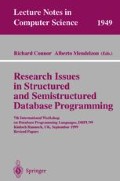Abstract
We consider two-dimensional spatial databases defined in terms of polynomial inequalities and focus on the potential of program- ming languages for such databases to express queries related to topo- logical connectivity. It is known that the topological connectivity test is not first-order expressible. One approach to obtain a language in which connectivity queries can be expressed would be to extend FO+Poly with a generalized (or Lindström) quantifier expressing that two points belong to the same connected component of a given database. For the expression of topological connectivity, extensions of first-order languages with recursion have been studied (in analogy with the classical relational model). Two such languages are spatial Datalog and FO+Poly+While. Although both languages allow the expression of non-terminating pro- grams, their (proven for FO+Poly+While and conjectured for spatial Datalog) computational completeness makes them interesting objects of study.
Previously, spatial Datalog programs have been studied for more restric- tive forms of connectivity (e.g., piece-wise linear connectivity) and these programs were proved to correctly test connectivity on restricted classes of spatial databases (e.g., linear databases) only.
In this paper, we present a spatial Datalog program that correctly tests topological connectivity of arbitrary compact (i.e., closed and bounded) spatial databases. In particular, it is guaranteed to terminate on this class of databases. This program is based on a first-order description of a known topological property of spatial databases, namely that locally they are conical.
We also give a very natural implementation of topological connectivity in FO+Poly+While, that is based on a first-order implementation of the curve selection lemma, and that works correctly on arbitrary spatial databases inputs. Finally, we raise the question whether topological con- nectivity of arbitrary spatial databases can also be expressed in spatial Datalog.
Access this chapter
Tax calculation will be finalised at checkout
Purchases are for personal use only
Preview
Unable to display preview. Download preview PDF.
References
S. Abiteboul, R. Hull, and V. Vianu. Foundations of Databases. Addison-Wesley, 1995.
M. Benedikt, G. Dong, L. Libkin, and L. Wong. Relational expressive power of constraint query languages. Journal of the ACM, 45(1): 1–34, 1998.
J. Bochnak, M. Coste, and M.-F. Roy. Géométrie Algébrique Réelle. Springer-Verlag, Berlin, 1987 (also Real Algebraic Geometry. Springer-Verlag, Berlin, 1998).
B.F. Caviness and J.R. Johnson (eds.) Quantifier Elimination and Cylindrical Algebraic Decomposition Springer-Verlag, Wien New York, 1998.
G.E. Collins. Quantifier elimination for real closed fields by cylindrical algebraic decomposition. In H. Brakhage, editor, Automata Theory and Formal Languages, volume 33 of Lecture Notes in Computer Science, pages 134–183, Berlin, 1975. Springer-Verlag.
S. Grumbach and J. Su. Finitely representable databases. Journal of Computer and System Sciences, 55(2): 273–298, 1997.
M. Gyssens, J. Van den Bussche, and D. Van Gucht. Complete geometrical query languages. in Proceedings of the 16th ACM Symposium on Principles of Database Systems, pages 62–67, ACM Press, New York, 1997.
J. Heintz, T. Reico, and M.-F. Roy. Algorithms in Real Algebraic Geometry and Applications to Computational Geometry. Discrete and Computational Geometry: Selected Papers from the DIMACS Special Year, Eds. J.E. Goodman, R. Pollack and W. Steiger, AMS and ACM, 6: 137–164, 1991.
J. Heintz, M.-F. Roy, and P. Solernò. Description of the Connected Components of a Semi-Algebraic Set in Single Exponential Time. Discrete and Computational Geometry, 11: 121–140, 1994.
P.C. Kanellakis, G.M. Kuper, and P.Z. Revesz. Constraint query languages. Journal of Computer and System Sciences, 51(1): 26–52, 1995 (Originally in Proceedings of the 9th ACM Symposium on Principles of Database Systems, pages 299–313, ACM Press, New York, 1990).
B. Kuijpers, J. Paredaens, M. Smits, and J. Van den Bussche. Termination properties of spatial Datalog programs. In D. Pedreschi and C. Zaniolo, editors, Proceedings of “Logic in Databases”, number 1154 in Lecture Notes in Computer Science, pages 101–116, Berlin, 1996. Springer-Verlag.
B. Kuijpers, J. Paredaens, and J. Van den Bussche. Topological elementary equivalence of closed semi-algebraic sets in the real plane. The Journal of Symbolic Logic, to appear, 1999.
B. Kuijpers and M. Smits. On expressing topological connectivity in spatial Datalog. In V. Gaede, A. Brodsky, O. Gunter, D. Srivastava, V. Vianu, and M. Wallace, editors, Proceedings of Workshop on Constraint Databases and their Applications, number 1191 in Lecture Notes in Computer Science, pages 116–133, Berlin, 1997. Springer-Verlag.
G. Kuper, L. Libkin, and J. Paredaens. Constraint databases. Springer-Verlag, 2000.
E.E. Moise. Geometric topology in dimensions 2 and 3, volume 47 of Graduate Texts in Mathematics. Springer, 1977.
J. Paredaens, J. Van den Bussche, and D. Van Gucht. Towards a theory of spatial database queries. In Proceedings of the 13th ACM Symposium on Principles of Database Systems, pages 279–288, ACM Press, New York, 1994.
J.T. Schwartz and M. Sharir. On the piano movers’ problem II. In J.T. Schwartz, M. Sharir, and J. Hopcroft, editors, Planning, Geometry, and Complexity of Robot Motion, pages 51–96. Ablex Publishing Corporation, Norwood, New Jersey, 1987.
A. Tarski. A Decision Method for Elementary Algebra and Geometry. University of California Press, Berkeley, 1951.
Author information
Authors and Affiliations
Editor information
Editors and Affiliations
Rights and permissions
Copyright information
© 2000 Springer-Verlag Berlin Heidelberg
About this paper
Cite this paper
Geerts, F., Kuijpers, B. (2000). Expressing topological connectivity of spatial databases. In: Connor, R., Mendelzon, A. (eds) Research Issues in Structured and Semistructured Database Programming. DBPL 1999. Lecture Notes in Computer Science, vol 1949. Springer, Berlin, Heidelberg. https://doi.org/10.1007/3-540-44543-9_14
Download citation
DOI: https://doi.org/10.1007/3-540-44543-9_14
Published:
Publisher Name: Springer, Berlin, Heidelberg
Print ISBN: 978-3-540-41481-0
Online ISBN: 978-3-540-44543-2
eBook Packages: Springer Book Archive

